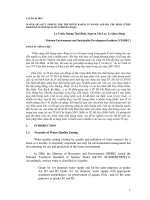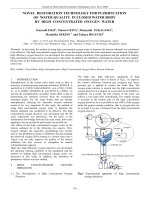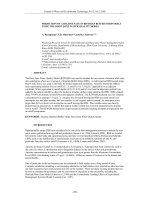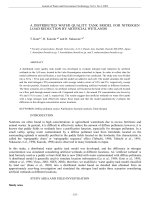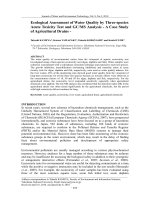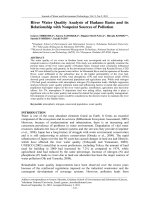water quality aquaculture
Bạn đang xem bản rút gọn của tài liệu. Xem và tải ngay bản đầy đủ của tài liệu tại đây (406.72 KB, 3 trang )
Tech Notes:
Water Quality & Aquaculture
Water quality and quantity vary from place to place, and are
affected by ecological factors such as soil and air quality. On a
whole, groundwater is considered more desirable for
aquaculture because it has more consistent water quality than
surface water, and is less likely to be contaminated by
pathogens or fish.
As it may be impractical to regulate large volumes of water in
open ponds or single pass flow-through culture systems,
species selection is largely dependent on the kind of water
available.
Tropical fish, for instance, are generally sensitive to poor water
quality and therefore require fish farmers to have a higher level
of water quality management skills; Ornamental fish are kept in
tanks more than food fish. In tank conditions where a large
number of fish is kept in a small confined space, the buildup of
nitrogenous waste requires additional care and measures to maintain a healthy stock.
Regardless of the kind of water available or the species chosen, all fish depend entirely on water to live, eat,
grow and perform other bodily functions. Therefore, it is no surprise that the success of a fish farming
establishment lies greatly on its water quality management programme.
The following are some parameters that are considered to be the most important in aquaculture:
pH, Alkalinity & Water Hardness
The acceptable range for fish culture is usually between pH 6.5 to pH 9.0. When water is very alkaline (> pH 9),
ammonium in water is converted to toxic ammonia, which can kill fish. On the other hand, acidic water (< pH 5)
leeches metals from rocks and sediments. These metals have an adverse effect on the fishes’ metabolism rates
and ability to take in water through their gills, and can be fatal as well.
pH, alkalinity and water hardness go hand-in-hand.
Alkalinity is the sum of the carbonate and bicarbonate alkalinities, which are responsible for neutralizing acid in
the water without changing the overall pH level.
Water hardness is similar to alkalinity but uses different measurements. It is a measure of mainly calcium,
magnesium and other ions.
The correct pH, alkalinity and hardness are essential for a successful pond fertility programme, where fertilizers
containing nitrogen, phosperous and potassium are added to encourage the growth of phytoplankton.
Phytonplankton breaks down waste into harmless ammonia, and is the food of zooplankton – a microscopic
animal which forage fish like bluegills feed on. Phytoplankton also produces dissolved oxygen during day
photosysnthesis and is the most important source of dissolved oxygen in pond systems.
Salinity
Typically, the salt concentration in a fish is about 0.5% higher than its surrounding water. As a result, there is a
constant influx of water into the fish through osmosis, diluting its body fluid. In order to maintain their salinity
level, fish are constantly excreting a stream of urine. At the same time, they absorb salt from their surrounding
via special cells in their gills. This constant exchange of mineral and water between the fish and their
surrounding is crucial for their survival.
Blk 55, Ayer Rajah
Crescent, #04-16/24
Singapore 139949
+65 6778 6876
+65 67730836 fax
www.thermofisher.com
When fish are stressed, as they are when being shipped around in bags, they react by leaking bodily minerals
into the water. If this condition persists for an extended period of time, the huge amount of salt lost can be
fatal for the fish. The survival chances of a fish can be significantly increased by adding salt to their transport
water. Since mineral leakage is directly linked to the concentration of salt between the fish and the water,
increasing salinity of the water reduces salt leakage and stress build-up for the fish.
Fish that have been imported in salted water need to be gradually acclimatized back to the salinity of their
original habitat, which may be as low as 100ppm. Gradual acclimatization should take place over several days
via a 30% daily water change.
Temperature
Aquatic animals take on the temperature of their environment and are intolerant of rapid temperature
fluctuations. This makes water an ideal living habitat for them, because water is a bad conductor of heat,
allowing large amount of heat energy to be absorbed without a corresponding temperature change.
Temperature tolerances of fish are broadly categorized into cold water, cool water, warm water and tropical
water. For each species, there is a minimum and maximum tolerance limit, as well as an optimal temperature
range for growth. This optimal temperature range, also known as the standard environmental temperature
(SET), may vary with each species, even those within the same temperature tolerance category, and with each
development stage of the fish.
Water temperature affects the feeding pattern and growth of fish. Fish generally experience stress and disease
breakout when temperature is chronically near their maximum tolerance or fluctuates suddenly. It is therefore
important to acclimatize fish gradually when moving them from one location to another.
Warm water holds less dissolved oxygen than cool water. This is a point worth noting, since every 10°C increase
in temperature doubles the rate of metabolism, chemical reaction and oxygen consumption in general.
Dissolved Oxygen
Dissolved oxygen is by far, the most important parameter in aquaculture. Low dissolved oxygen levels are
responsible for more fish kills, either directly or indirectly, than all other problems combined. Oxygen
consumption is directly linked to size, feeding rate, activity level and temperature, and it will surprise some that
large fish consume less oxygen than their smaller counterparts which have higher metabolic rates. The amount
of dissolved oxgen in water increases as temperature reduces, and decreases when salinity and altitude
increases:
Temperature °C (°F)
Variable
20.0 °C
(68.0 °F)
22.0 °C
(71.6 °F)
26.0 °C
(78.8 °F)
28.0 °C
(82.4 °F)
30.0 °C
(86.0 °F)
Oxygen (ppm)
0 ppm
9.2 ppm
8.8 ppm
8.2 ppm
7.9 ppm
7.6 ppm
Salinity
5,000 ppm
8.7 ppm
8.4 ppm
7.8 ppm
7.5 ppm
7.3 ppm
(ppm)
10,000 ppm
8.3 ppm
8.0 ppm
7.4 ppm
7.1 ppm
6.9 ppm
0 ft (sea level)
9.2 ppm
8.8 ppm
8.2 ppm
7.9 ppm
7.6 ppm
Altitude
1,000 ft
8.8 ppm
8.5 ppm
7.9 ppm
7.6 ppm
7.4 ppm
(ft)
2,000 ft
78.5 ppm
8.2 ppm
7.6 ppm
7.3 ppm
7.1 ppm
Table 1: Solubility of oxygen (ppm) in water at various water temperatures, salinities and altitudes (Source: LaDon Swann,
)
Not only is dissolved oxygen important for fish respiration, it is also important for the survival of
phytoplankton, the organism which breaks down toxic ammonia into harmless forms.
To cultivate good growth, a good rule of thumb is to maintain DO levels at saturation, or at least 5 ppm. Warm
water species are more well-adapted to ocassional low DO levels than cool water species.. Portable dissolved
oxygen meters, such as the Eutech EcoScan DO 6, should suffice for a quick DO check.
Check Your Water Quality Frequently & Regularly
Water quality is the biggest concern to an aquaculturist or fish farmer, who must become accustomed to
frequent and regular water quality analyses. Lightweight pocket testers are available in the market for
measurements of various parameters such as pH, temperature, salinity, conductivity, dissolved oxygen and
total dissolved solids.
A multiparameter pocket tester such as Eutech’s PCSTestr 35 will allow users to measure and scan through
several parameters simply by pressing a button, and can prove to be very convenient in such multiparameter
applications.
References
Howerton, Robert (2001) Best Management Practices for Hawaiian Aquaculture, Center for Tropical Aquaculture
Publication No. 148
Summerfelt, Robert C. (n.d.) Water Quality Considerations for Aquaculture, Aquaculture Network Information
Center ()
Swann, LaDon (n.d.) A Fish Farmer’s Guide to Understanding Water Quality, Aquaculture Network Information
Center ()
Watson , Craig A. and Shireman, Jerome V. (1996) Production of Ornamental Aquarium Fish, Department of
Fisheries and Aquatic Sciences: Document FA-35

